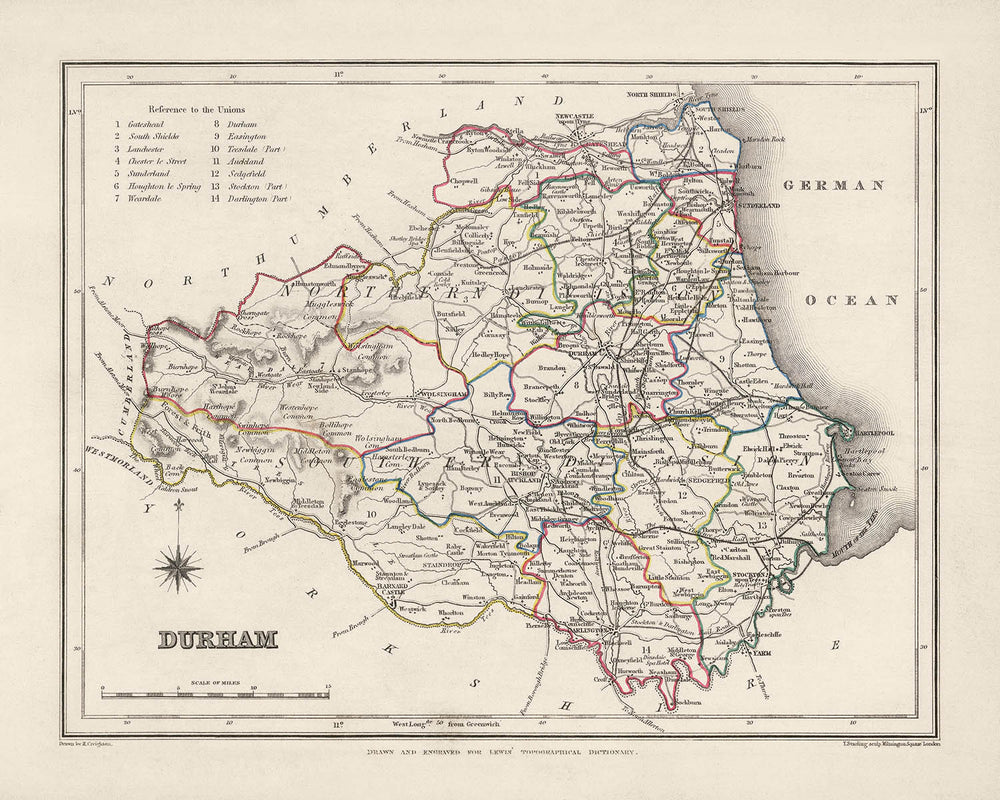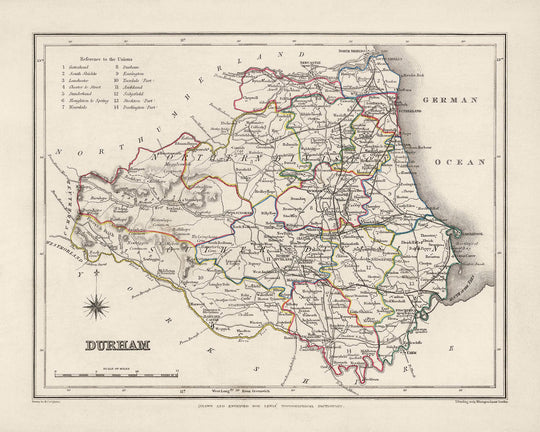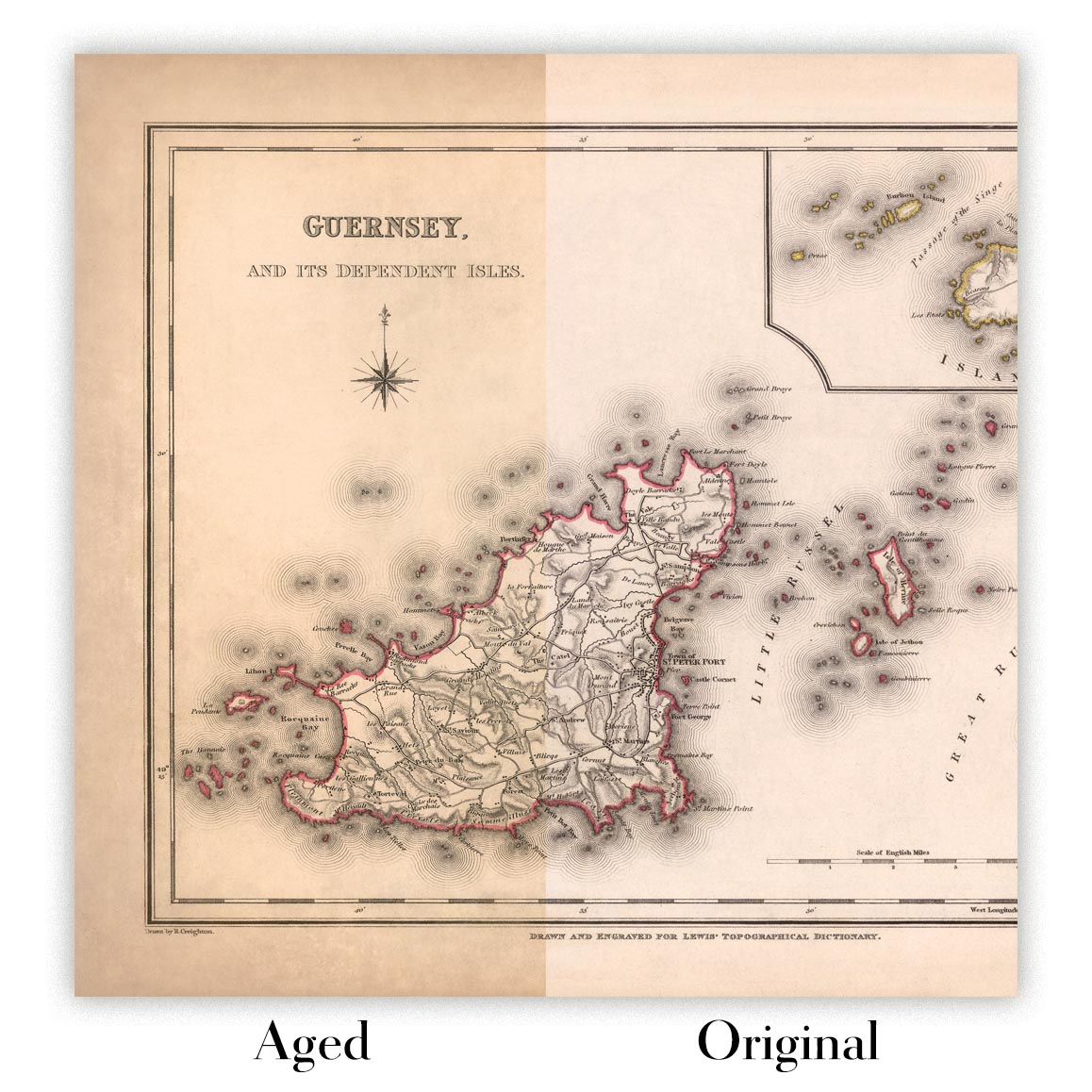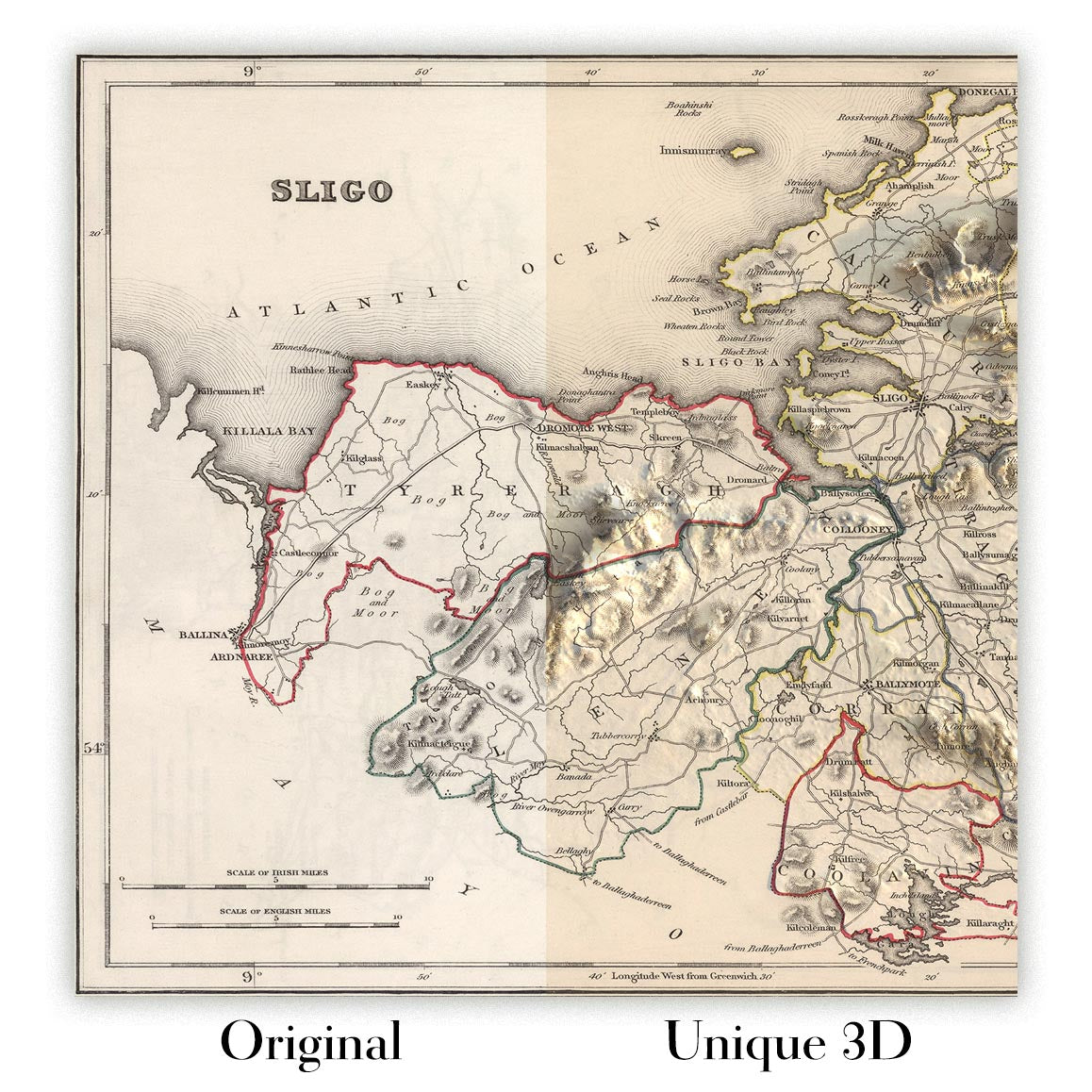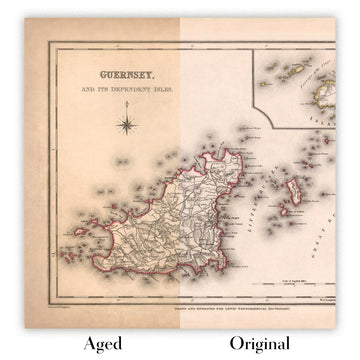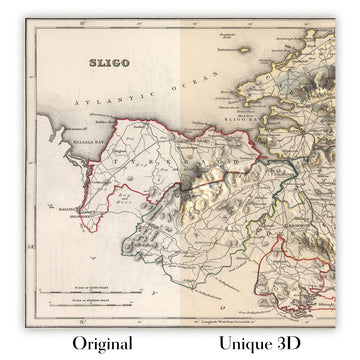- Handmade locally. No import duty or tax
- FREE Delivery by Christmas
- Love it or your money back (90 days)
- Questions? WhatsApp me any time
Own a piece of history
5,000+ 5 star reviews


This old map of the County of Durham, England, created by Samuel Lewis in 1844, offers a fascinating glimpse into the historical landscape of the region. With its intricate details and exquisite craftsmanship, this map is a true collector's item for history enthusiasts and map lovers alike.
One of the captivating aspects of this map is its depiction of the major towns and cities of the time. While Durham itself is not included, the map showcases other significant locations within the county. Sunderland, a bustling port town known for its shipbuilding industry, is prominently featured. Stockton-on-Tees, with its rich history as a market town and river port, is also highlighted. The map captures the maritime heritage of Hartlepool, a coastal town that played a vital role in trade and defense. Bishop Auckland, known for its medieval castle and historic connections to the Bishops of Durham, adds another layer of intrigue. Lastly, Darlington, a town renowned for its railway heritage, completes the list of notable features on this remarkable map.
It is important to note that while some modern cities may not be present on this map, it offers a unique perspective on the region's past. Excitingly, certain settlements may appear under earlier names, allowing us to trace the evolution of place names over time. This map serves as a visual time capsule, transporting us back to the mid-19th century and providing valuable insights into the historical geography of County Durham.
Notable settlements founded before 1840 within the historical boundaries of County Durham:
- Durham (995): The historic county town and ecclesiastical center, renowned for its magnificent cathedral and castle.
- Sunderland (1179): A significant port town with a rich maritime heritage and a thriving coal industry.
- Stockton-on-Tees (1138): A market town and river port, historically known for its association with the Stockton and Darlington Railway.
- Hartlepool (640): A coastal town with a long history of maritime trade and defense, including its famous Headland and ancient Abbey.
- Darlington (1183): A town renowned for its railway heritage, as the location of the world's first passenger railway station.
- Bishop Auckland (1093): A historic market town with ties to the Bishops of Durham, featuring the impressive Auckland Castle.
- Chester-le-Street (883): A town with a rich history dating back to Roman times, known for its association with cricket and the iconic Lumley Castle.
- Gateshead (12th century): Situated on the southern bank of the River Tyne, it has a long history as an important crossing point and industrial center.
- South Shields (1245): A coastal town with a strong maritime tradition, boasting beautiful beaches and historic landmarks.
- Houghton-le-Spring (12th century): A town with a rich religious history, home to the picturesque Houghton Hall and its surrounding parkland.
- Washington (1096): An ancient settlement with connections to George Washington's ancestors, featuring the stunning Washington Old Hall.
- Jarrow (681): An historic town known for its association with the Venerable Bede and its medieval monastery, St. Paul's Church.
- Seaham (1828): A coastal town with a fascinating industrial heritage, including the remnants of the once-thriving Seaham Colliery.
- Peterlee (1948): A new town established after World War II, designed to accommodate the growing mining community.
- Consett (1840): A town that emerged during the Industrial Revolution, renowned for its steel and ironworks.
Additional notable settlements founded before 1840 within the historical boundaries of County Durham include:
- Stanley (12th century): A former coal mining town with a rich industrial heritage.
- Billingham (685): An ancient settlement with a history of agriculture and chemical manufacturing.
- Newton Aycliffe (1947): A new town created after World War II, originally designed as an industrial center.
- Shildon (1823): A town closely associated with the birth of the railway industry, housing the National Railway Museum.
- Ferryhill (1840): A town that developed due to the expansion of the coal mining industry in the 19th century.
- Spennymoor (1840): A town that grew rapidly during the Industrial Revolution, fueled by the coal mining and iron industries.
- Chester Moor (12th century): A village with a long history, located near the banks of the River Wear.
- Sedgefield (13th century): An ancient market town with a rich historical heritage, including connections to the Magna Carta.
- Crook (1840): A town that emerged during the Industrial Revolution, known for its coal mining and textile industries.
- Brandon (12th century): A village with a long history, situated near the River Wear and the city of Durham.
- Easington (12th century): A coastal town with a history of coal mining and a beautiful nature reserve.
- Willington (1840): A town that developed due to the expansion of the coal mining industry in the 19th century.
- Wingate (1840): A former mining village that grew rapidly during the Industrial Revolution.
- Murton (1840): A town that emerged during the Industrial Revolution, driven by the coal mining industry.
- Trimdon (12th century): A village with a long history, associated with the noble family of De Brus.
Notable boundaries, rivers, and natural attractions in County Durham, England:
- River Tyne: A major river forming the boundary between County Durham and Tyne and Wear, known for its iconic bridges and vibrant quayside.
- River Wear: A significant river flowing through Durham, Sunderland, and other towns, with its picturesque valleys and historic bridges.
- Durham Dales: A stunning upland area encompassing the North Pennines Area of Outstanding Natural Beauty, offering breathtaking landscapes and charming villages.
- Durham Heritage Coast: A beautiful coastline stretching from Sunderland to Hartlepool, featuring dramatic cliffs, sandy beaches, and wildlife-rich habitats.
- Hamsterley Forest: A vast forested area in the Durham Dales, providing opportunities for outdoor activities such as walking, cycling, and wildlife spotting.
- High Force: A mesmerizing waterfall on the River Tees, one of England's most impressive natural wonders.
- Durham Cathedral and Castle: A UNESCO World Heritage Site, housing the magnificent Durham Cathedral and the historic Durham Castle.
Notable historical events in County Durham between 1800 and 1850:
- 1825: Opening of the Stockton and Darlington Railway, the world's first public railway to use steam locomotives.
- 1832: The Reform Act of 1832, which extended voting rights and reformed parliamentary representation, had an impact on County Durham.
- 1838: The Durham Miners' Gala, an annual event that started as a celebration of trade unionism and workers' rights, began in Durham City.
Please note that this list is not exhaustive, and there may be other significant settlements, boundaries, or events that are relevant to the history and geography of County Durham during this period.
Please double check the images to make sure that a specific town or place is shown on this map. You can also get in touch and ask us to check the map for you.
This map looks great at all sizes: 12x16in (30.5x41cm), 16x20in (40.5x51cm), 18x24in (45.5x61cm), 24x30in (61x76cm), 32x40in (81.5x102cm) and 40x50in (102x127cm), but it looks even better when printed large.
I can create beautiful, large prints of this map up to 50in (127cm). Please get in touch if you're looking for larger, customised or different framing options.
The model in the listing images is holding the 16x20in (40.5x51cm) version of this map.
The fifth listing image shows an example of my map personalisation service.
If you’re looking for something slightly different, check out my main collection of UK and Ireland maps.
Please contact me to check if a certain location, landmark or feature is shown on this map.
This would make a wonderful birthday, Christmas, Father's Day, work leaving, anniversary or housewarming gift for someone from the areas covered by this map.
This map is available as a giclée print on acid free archival matte paper, or you can buy it framed. The frame is a nice, simple black frame that suits most aesthetics. Please get in touch if you'd like a different frame colour or material. My frames are glazed with super-clear museum-grade acrylic (perspex/acrylite), which is significantly less reflective than glass, safer, and will always arrive in perfect condition.
This map is also available as a float framed canvas, sometimes known as a shadow gap framed canvas or canvas floater. The map is printed on artist's cotton canvas and then stretched over a handmade box frame. We then "float" the canvas inside a wooden frame, which is available in a range of colours (black, dark brown, oak, antique gold and white). This is a wonderful way to present a map without glazing in front. See some examples of float framed canvas maps and explore the differences between my different finishes.
For something truly unique, this map is also available in "Unique 3D", our trademarked process that dramatically transforms the map so that it has a wonderful sense of depth. We combine the original map with detailed topography and elevation data, so that mountains and the terrain really "pop". For more info and examples of 3D maps, check my Unique 3D page.
For most orders, delivery time is about 3 working days. Personalised and customised products take longer, as I have to do the personalisation and send it to you for approval, which usually takes 1 or 2 days.
Please note that very large framed orders usually take longer to make and deliver.
If you need your order to arrive by a certain date, please contact me before you order so that we can find the best way of making sure you get your order in time.
I print and frame maps and artwork in 23 countries around the world. This means your order will be made locally, which cuts down on delivery time and ensures that it won't be damaged during delivery. You'll never pay customs or import duty, and we'll put less CO2 into the air.
All of my maps and art prints are well packaged and sent in a rugged tube if unframed, or surrounded by foam if framed.
I try to send out all orders within 1 or 2 days of receiving your order, though some products (like face masks, mugs and tote bags) can take longer to make.
If you select Express Delivery at checkout your order we will prioritise your order and send it out by 1-day courier (Fedex, DHL, UPS, Parcelforce).
Next Day delivery is also available in some countries (US, UK, Singapore, UAE) but please try to order early in the day so that we can get it sent out on time.
My standard frame is a gallery style black ash hardwood frame. It is simple and quite modern looking. My standard frame is around 20mm (0.8in) wide.
I use super-clear acrylic (perspex/acrylite) for the frame glass. It's lighter and safer than glass - and it looks better, as the reflectivity is lower.
Six standard frame colours are available for free (black, dark brown, dark grey, oak, white and antique gold). Custom framing and mounting/matting is available if you're looking for something else.
Most maps, art and illustrations are also available as a framed canvas. We use matte (not shiny) cotton canvas, stretch it over a sustainably sourced box wood frame, and then 'float' the piece within a wood frame. The end result is quite beautiful, and there's no glazing to get in the way.
All frames are provided "ready to hang", with either a string or brackets on the back. Very large frames will have heavy duty hanging plates and/or a mounting baton. If you have any questions, please get in touch.
See some examples of my framed maps and framed canvas maps.
Alternatively, I can also supply old maps and artwork on canvas, foam board, cotton rag and other materials.
If you want to frame your map or artwork yourself, please read my size guide first.
My maps are extremely high quality reproductions of original maps.
I source original, rare maps from libraries, auction houses and private collections around the world, restore them at my London workshop, and then use specialist giclée inks and printers to create beautiful maps that look even better than the original.
My maps are printed on acid-free archival matte (not glossy) paper that feels very high quality and almost like card. In technical terms the paper weight/thickness is 10mil/200gsm. It's perfect for framing.
I print with Epson ultrachrome giclée UV fade resistant pigment inks - some of the best inks you can find.
I can also make maps on canvas, cotton rag and other exotic materials.
Learn more about The Unique Maps Co.
Map personalisation
If you're looking for the perfect anniversary or housewarming gift, I can personalise your map to make it truly unique. For example, I can add a short message, or highlight an important location, or add your family's coat of arms.
The options are almost infinite. Please see my map personalisation page for some wonderful examples of what's possible.
To order a personalised map, select "personalise your map" before adding it to your basket.
Get in touch if you're looking for more complex customisations and personalisations.
Map ageing
I have been asked hundreds of times over the years by customers if they could buy a map that looks even older.
Well, now you can, by selecting Aged before you add a map to your basket.
All the product photos you see on this page show the map in its Original form. This is what the map looks like today.
If you select Aged, I will age your map by hand, using a special and unique process developed through years of studying old maps, talking to researchers to understand the chemistry of aging paper, and of course... lots of practice!
If you're unsure, stick to the Original colour of the map. If you want something a bit darker and older looking, go for Aged.
If you are not happy with your order for any reason, contact me and I'll get it fixed ASAP, free of charge. Please see my returns and refund policy for more information.
I am very confident you will like your restored map or art print. I have been doing this since 1984. I'm a 5-star Etsy seller. I have sold tens of thousands of maps and art prints and have over 5,000 real 5-star reviews. My work has been featured in interior design magazines, on the BBC, and on the walls of dozens of 5-star hotels.
I use a unique process to restore maps and artwork that is massively time consuming and labour intensive. Hunting down the original maps and illustrations can take months. I use state of the art and eye-wateringly expensive technology to scan and restore them. As a result, I guarantee my maps and art prints are a cut above the rest. I stand by my products and will always make sure you're 100% happy with what you receive.
Almost all of my maps and art prints look amazing at large sizes (200cm, 6.5ft+) and I can frame and deliver them to you as well, via special oversized courier. Contact me to discuss your specific needs.
Or try searching for something!









